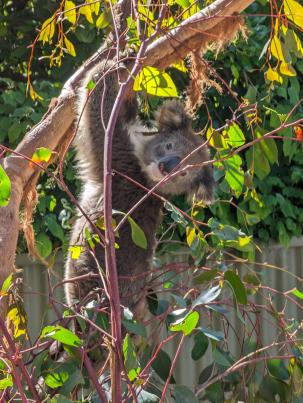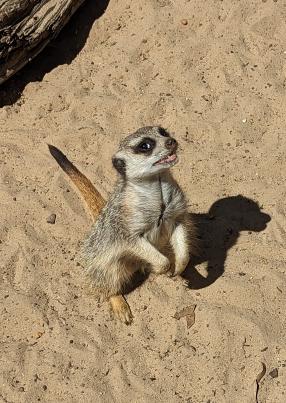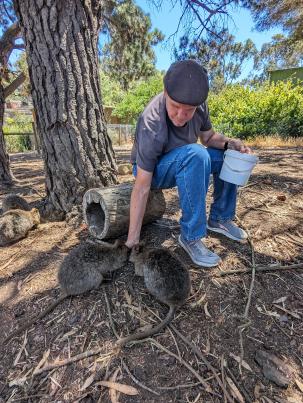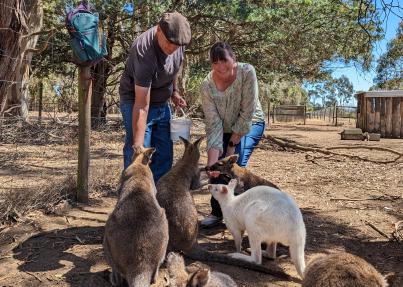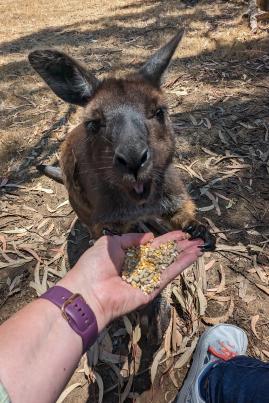Kangaroo Island Wildlife Park
Parndana, Kangaroo Island, Australia
December 3, 2023
Today was the day I dreamed of my whole life….
….to hold a koala & bottle feed a baby joey!
Both of which I was lucky enough to experience at this amazing little sanctuary on Kangaroo Island called KI Wildlife Park. It’s been in business since the early 1990’s and focuses on providing a safe place for non-releasable native wildlife. There is a special focus on educating the public to becoming good stewards for the animals that call Kangaroo Island home.
When the bush fires of 2019/2020 came roaring through the island, the refuge established the Kangaroo Island Koala and Wildlife Rescue Centre. During those first weeks/months after the fires they had over 600 koalas, kangaroos, echidnas, goannas, birds and possums come through the centre in need of critical care for burns, dehydration and starvation. Those saved & treated were released back into the wild. Some of the joeys that were orphaned due to the fire became non-releasable due to imprinting during handraising process and now live the sweet life at the refuge.
We opted for a private tour, which meant Chuck and I got one on one time with Steve, an animal care specialist, for a special 3 hour adventure! Our 1st stop was meeting Pearl, the koala. She is the sweetest, most loving little koala and actually LOVES to be held! I got to hold her first and seriously I just nuzzled right into her little head, I may have teared up a little bit with emotion. She was so gentle and seemed to be smiling as she moved between me and Chuck for snuggles. Steve tried to put her away to grab a baby koala for us to see, but Pearl would have nothing to do with that and insisted she be held again. It was precious.
We continued on our tour to the hospital and nursery where there just happened to be 1 baby joey still in care for this season, a Western Grey Kangaroo. Here’s where dream #2 came true….bottle feeding that little joey as he snuggled in his pillowcase pouch! He was a greedy little eater and gobbled up his special marsupial milk quickly. Again, I’ll spare you the ugly crying pictures, but happy doesn’t even begin to express how much that experience meant to me.
We moved along and visited some creepy crawly reptiles and large crocodiles, a pack of dingoes (who howled for us), and a sleeping little wombat. Then we were surprised with a quick stop to feed the Meerkats. They were crazy wild and clamoring for their treat of fresh peas! Who knew Meerkats were so feisty?!
Our next surprise was one on one time with the marmosets named Link (father) and Navi (daughter). Navi was a cheeky little monkey who actually bullies her father. So Chuck and I tagged team them to make sure they both got equal treats of watermelon and apple. Navi made herself at home on Chucks head, probably asserting her dominance even though she literally weighs 300grams (10 oz or less).
We swung by the long nosed echidna’s enclosure for a quick pet. I think we learned the most here, did you know that echidnas as well as platypuses are the ONLY mammals to lay eggs? The females lay one egg a year, which is the size of a grape & leathery. The momma rolls the egg up to a “fake” pouch, really a deep fold of skin, on her belly to keep it safe. About 10 days later the puggle (how cute is that name?) hatches and snuggles in, lapping up the “milky goo” secreted from moms skin folds. The baby echidna stays with mom, in a den for about a year. Their spikes are made of keratin and are quite hard, basically long, hollow hair follicles. They can break off like a fingernail. The thick spines are used for defense. They can quickly roll into a ball or burrow enough to allow the spikes to protrude and deter any predators. They are actually toothless and have a long, sticky tongue like an anteater to snag small insects for dinner. We have a newfound respect for these adorable little nocturnal critters.
Next stop….Quokkas! Oh yes we did, we got right inside their enclosure and handfed the cute little buggers. Quokkas are herbivores eating a variety of things like leaves, stems, bark and grasses. Think of them as big kangaroo-like rats! They can survive long periods of time without food and water by living off fat stores in their tails. They were super friendly and eager to snack.
As if our tour wasn’t already perfect and exciting…we were taken to the Servals next, Sabor and Cali. My first thought was WHAT? We can actually go INSIDE the enclosure with a big cat, two at that? I thought there is no way this is really happening; I know how our bobcats, Jaggar and Oliver, are at Back To Nature and there is NO WAY I would go inside their enclosures! But….as it turns out, Sabor and Cali are the sweetest, purry little kitties ever. Fun fact: thanks to their long legs, servals can run up to 45mph and jump 9 feet! I’m just glad they were sweet, because there was no way I could outrun them! We got to feed them dinner which consisted of raw chicken and fish. Chuck fed Sabor and he quickly ate everything while I fed Cali, who was quite particular in that she did not want her fish, only chicken! Sabor got a little extra fish that day! We were allowed a quick little rub down on Sabor while he enjoyed a cracked egg treat.
I think by this point our cup runneth over but we weren’t finished! We headed into the kangaroo and wallaby enclosures with a bucket full of roo food! Steve left us to have as much time as we wanted hanging out and feeding the roos. Most of these guys were orphaned at a young age and hand raised, making them super sweet and ready for a selfie! We encountered red tammar wallabies, western grey kangaroos, and even an albino roo. They could get a little greedy with the roo food but we had plenty to go around!
I still can’t believe what all we experienced on this tour, it was a DREAM COME TRUE for sure! If you are given the opportunity to visit, you won’t be disappointed!
After our tour, we were able to just wander back around to see what we missed on the actual tour...birds! So many birds! Here are a few of our favorites:



